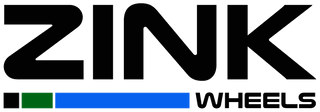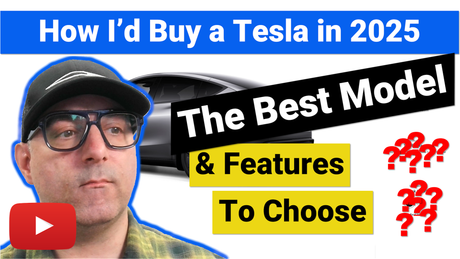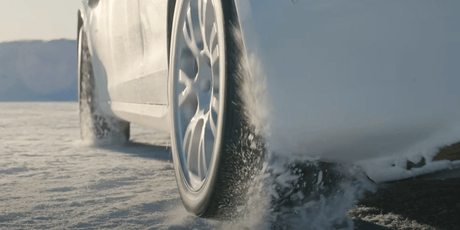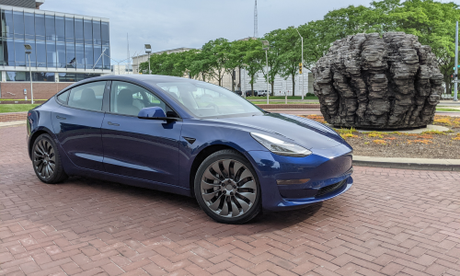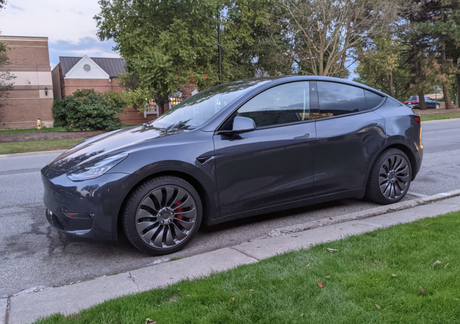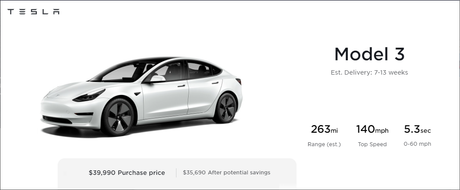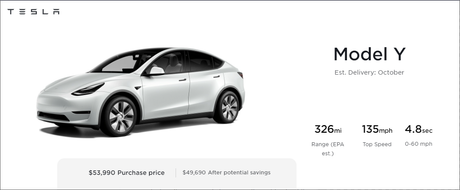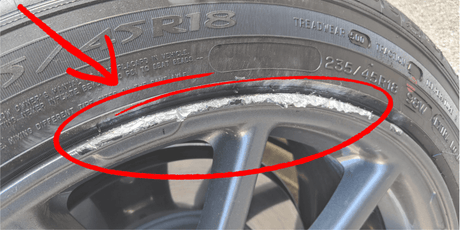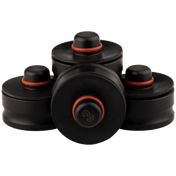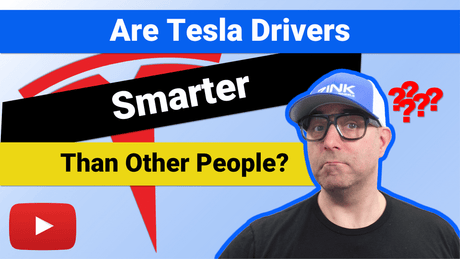
Guide To Ordering a New Tesla Model Y - How To Pick The Right Options
Congratulations! You've finally made the decision to order a Tesla Model Y. The next most important step is visiting the Tesla website and placing your order. But which options should you pick for your new vehicle?
Tesla has made the mechanics of ordering a new vehicle very easy... but if you've never owned a Tesla before, then you may not know how to select from the choices that you're presented with. Long Range or Performance? Gemini or Induction wheels? Blue or Midnight Silver Metallic? What about accessories?
I wrote this guide to help you make the best choices based on your budget and your needs. The images shown here are captured from the Tesla.com website using a web browser on a full-sized computer screen. If you visit Tesla's website using a tablet, smartphone, or other mobile device, then the screens may look different... but they should show the same choices.
Please also be aware that Tesla changes vehicle options from time to time; the options described here were shown on the Tesla website as of July 15th, 2021.
Before Making ANY Choices...
When you first visit the Tesla Model Y order page (https://www.tesla.com/modely/design), you're presented with a picture of the base Model Y vehicle with a series of choices on the right side of the screen.
HOWEVER... all prices initially shown on the page are calculated based on the 'Potential Savings' that you may receive by driving an electric vehicle instead of a gas-powered one. In the upper-right corner of the page, there are two options...
- Purchase Price
- Potential savings*
...and 'Potential savings' is pre-selected.
If you follow the asterisk (*) and read the 'fine print' lower on the page, it states: "Prices above include potential incentives and gas savings of $4,300."
If the actual purchase price is important to you (as it is with many of us), then I suggest that you immediately select 'Purchase Price' instead of 'Potential savings', as this reflects the actual amount of money that you need to have in-hand (or finance) when you purchase your Model Y. You will see that all of the prices on the page change automatically to reflect the true purchase price of the vehicle that you're building. Every time you select a different option on the page, it automatically updates your purchase price to reflect your choices.
Selecting the Powertrain
The next choice is the vehicle's powertrain configuration...
- Long Range
- Performance
...and 'Long Range' is pre-selected.
'Long Range' and 'Performance' are all-wheel-drive (AWD) powertrains... meaning that the front and rear wheels are powered by motors. If you live in a colder climate where snowy or icy roads are something that you deal with regularly, then either of these powertrain options will serve you well with great traction and stability. The 'Long Range' powertrain provides the longest driving range on a single charge -- 326 miles -- and is a nice compromise between driving range and sportiness. You get sporty acceleration (0-to-60mph in a quick 4.8 seconds)... but you're not getting there quite as quickly as the 'Performance' powertrain (3.5 seconds... yowza!).
The 'Performance' powertrain is definitely the sportier option in terms of acceleration and appearance... but it sacrifices driving range a bit (303 miles on a single charge) and you get a less comfortable ride due to the lowered suspension and the large 21" Uberturbine wheels.
When you select the 'Performance' powertrain, you get some added features that are mostly cosmetic: bright red 'Performance' brake calipers, a carbon fiber rear spoiler on the rear hatch, and aluminum alloy brake and accelerator pedals instead of the standard rubber pedals. Sure, the brakes might have a bit more "whoah", but if you drive your Tesla as-intended using the regenerative braking, then you'll rarely need the upgraded brakes.
If you want the absolute fastest and hottest-looking Model Y, then the $8,000 'Performance' upgrade is for you. If you have a lead foot, you want to take your Model Y to the race track, or you simply want to be able to crush any other crossover at the stoplight, then this option is for you.
If you want a fun-to-drive (every Model Y is fun to drive) and great-looking car (every Model Y is great-looking) but value the longer driving range and the smoother ride, then you may want to save $8,000 and pick the 'Long Range' powertrain. If you like the cosmetic features that come with the 'Performance' powertrain option, then you can always buy aftermarket spoilers, pedals, etc. to give you the same sporty appearance... for a fraction of the price.
If maximizing the driving range of the Model Y is most important to you, then select the 'Long Range' powertrain.
If maximizing the speed and performance of the Model Y is most important to you, then select the 'Performance' powertrain.
Selecting the Paint Color
The next choice is the vehicle's exterior paint color...
- Pearl White Multi-Coat
- Solid Black
- Midnight Silver Metallic
- Deep Blue Metallic
- Red Multi-Coat
...and 'Pearl White Multi-Coat' is pre-selected.
If you stick with 'Pearl White Multi-Coat', then you can keep moving through the design process without paying anything extra. All of the other colors cost $1,000-$2,000 extra. They're all beautiful... just pick the one you like the most. If you're looking for ways to save money, then pick white and move on. Trust me... they all look great.
Selecting the Wheels
The next choice is the vehicle's wheels; if you selected the 'Long Range' powertrain, then you have two wheel options...
- 19" Gemini Wheels
- 20" Induction Wheels
...and '19" Gemini Wheels' are pre-selected.
If you selected the 'Performance' powertrain, then you have no wheel choices; the vehicle will be automatically equipped with the '21" Uberturbine Wheels'... like them or not.
The '19" Gemini Wheels' offer the smoothest ride of all three wheel options, since they have the smallest wheel diameter (19")... therefore there's more room left over for taller tires inside each wheel well. Taller tires typically provide a smoother ride.
The '19" Gemini Wheels' arrive equipped with plastic snap-on wheel covers that deliver improved aerodynamic performance, thus giving you slightly increased driving range... which is very important to some people. Estimates vary depending upon who you ask, but owners commonly report between 1% and 5% improvement.
HOWEVER... the '19" Gemini Wheels' have an added surprise that Tesla does not clearly advertise on their website. If you want a sportier look (some people don't like the appearance of the plastic Gemini wheels), then you can remove the plastic Gemini wheel covers. They're held in-place with metal clips, and when you pull them off, you'll see very nice-looking 7-spoke silver wheels underneath. Some people purchase an aftermarket storage bag for their Gemini wheel covers and keep them in their garage, basement, or trunk... then when they want to take a road trip, they snap them back in-place for some added efficiency and driving range. You'll need to purchase a set of caps to cover the ugly stock steel lug nuts and the wheel center hole that's left behind, but you're left with a nice, sporty-looking wheel.
The '20" Induction Wheels' are an upgrade from the '19" Gemini Wheels' in both appearance and price. For an extra $2,000, you get a slightly larger diameter black wheel that provides a slightly stiffer, sportier ride (because the tires are slightly shorter). Although these wheels aren't covered by large plastic wheel covers, there is a small round plastic cover that snaps into the center of each wheel to cover the ugly stock steel lug nuts and the wheel's center hole.
If you didn't select the 'Performance' powertrain option, then just pick which wheel ('19" Gemini Wheels' or '20" Induction Wheels') you like the most. If you don't really care, or if you want to save $2,000, then go with the '19" Gemini Wheels' and move on.
As I stated earlier, if you did select the 'Performance' powertrain option, then your new Model Y will be automatically equipped with the '21" Uberturbine Wheels'. These are beautiful wheels, but they have a few drawbacks:
- Because they have a larger diameter, there is less room in the wheel wells for tires... so the tires are shorter, leading to a rough ride and increased risk of tire blow-outs.
- They're quite heavy due to their larger size... so if you plan to race your Model Y, you won't have the optimum acceleration or braking due to the large "unsprung mass" (racing experts and automotive experts know what this means).
- They're "staggered" from front to rear -- meaning that the rear wheels and tires are wider (10.5" wide) than the front wheels and tires (9.5") -- therefore you cannot properly rotate the tires to increase their longevity.
If you don't like any of the wheel options that Tesla offers on this page, then there are custom aftermarket wheel alternatives that you can purchase to replace the stock Tesla wheels. People often replace their stock Tesla 19" Gemini wheels, 20" Induction wheels, and 21" Uberturbine wheels with aftermarket wheels for various reasons, including:
- They want to give their Model Y a unique appearance.
- They don't like the appearance of any of the stock Tesla Model Y wheels, and want to replace them with something better-looking.
- They like the appearance of the 21" Uberturbine wheels, but they don't like how large or heavy they are.
- They want to have a second set of wheels with winter tires installed, making it easy to switch between summer and winter tires each year.
- They want to purchase a nicer set of summer wheels and use the stock Tesla wheels solely for winter tires.
Regardless of their reasons, many people purchase custom aftermarket wheels for their Tesla Model Y. Sometimes they keep the stock Tesla wheels that came with their vehicle, and sometimes they sell them to recoup part of the cost of purchasing the new wheels.
If you purchase aftermarket wheels for your Tesla Model Y and they are the same size (19", 20", or 21") as the stock wheels, then you can ask your Tesla Service Center, a local tire shop, or a mobile tire service to move the stock tires and TPMS (Tire Pressure Monitoring System) sensors onto your new custom wheels. You can then keep the stock wheels or sell them to someone else who wants them.
If your new wheels are not the same size as the stock wheels on your Model Y, then you will need to purchase a new set of tires that are sized to fit your new wheels. If you're going to keep the stock Tesla wheels as well as your new wheels (such as a winter / summer scenario), then you'll also need to purchase a new set of TPMS sensors for the new wheels, as each set of wheels you own needs to have its own set of TPMS sensors. The new TPMS sensors can be installed in the new wheels at the same time as the new tires.
One great option for custom aftermarket Tesla Model Y wheels is the 20" ENTERPRISE wheel from Zink Wheels. They're available in three colors (Carbon Black, Stardust Silver, and Borealis Bronze), they're engineered for strength and safety, and they give the Model Y a distinctive and futuristic look.
Check out the ENTERPRISE wheels for Tesla Model Y here:
Tesla Model Y Fully-Forged Wheels
Selecting the Tow Hitch
The next choice is a fairly straightforward one; if you want your new Model Y to arrive with a towing hitch pre-installed, then you simply select the option to add the hitch and move on. If you don't foresee needing the 2-inch Class II hitch receiver for carrying cargo, transporting bikes, towing trailers, etc... then skip this option and save $1,000.
If you don't choose the towing hitch and change your mind later, then you can order a hitch from Tesla and have it installed by them for $1,200. There are also aftermarket hitches that can be installed later... but they won't be covered by the Tesla warranty, and the vehicle won't have 'Trailer Mode' which changes the way that the vehicle behaves when towing a load.
Selecting the Interior
The next choice is the vehicle's interior color scheme...
- All Black
- Black and White
...and 'All Black' is pre-selected.
If you stick with 'All Black', then you can keep moving through the design process without paying anything extra. Selecting 'Black and White' will give you great-looking white seats and a white dash, and it will cost you $1,000 extra. Both color schemes look great... just pick the one you like the most. If you're looking for ways to save money, then pick 'All Black' and move on. If you're looking for something a bit more unique -- or a bit more sophisticated -- then pick 'Black and White'. Be warned, though, that white seats will get dirty with time, and your blue jeans will transfer blue ink to the white seats over time. They can be cleaned, but it will be an added maintenance effort if you want to keep the seats looking great. The 'All Black' interior is much easier to keep clean.
Selecting Seating Layout
The next choice is the vehicle's seating layout...
- Five Seat Interior
- Seven Seat Interior
...and 'Five Seat Interior' is pre-selected.
The 'Five Seat Interior' layout provides you with two front seats and a bench-style second-row seat that holds three people and folds flat for more cargo space if needed. The second row can hold three adults, but they may not be comfortable on a long trip.
The 'Seven Seat Interior' layout provides you with two front seats, a bench-style second-row seat that holds three people and that folds flat, and a smaller bench-style third-row seat that holds two people and folds flat. This option costs an additional $3,000. As with the 'Five Seat Interior' option, the second row can hold three adults, but they may not be comfortable on a long trip. The third-row can hold two adults, but they also will not be comfortable for long. There isn't as much head room in the third row, so it's much better-suited for kids.
If you anticipate needing seating for up to seven people, then you can choose the 'Seven Seat Interior' option. If you don't need all that seating, then save yourself $3,000, pick the 'Five Seat Interior', and move on.
Selecting Full Self-Driving Capability
The final choice you'll need to make is whether you want the 'Full Self-Driving' (also known as 'FSD') features. Many people are confused by what this means... especially since all new Tesla vehicles come equipped with 'Autopilot' features.
'Full Self-Driving Capability' comes with a hefty $10,000 price tag... so what do you get for the extra money?
Let's start by reviewing the features of 'Autopilot'... which comes standard with all new Tesla vehicles.
'Autopilot' is a set of features that makes it easier to drive on most highways and freeways... and some other roads and streets. 'Autopilot' basically consists of two main features... 'Adaptive Cruise Control' and 'Autosteer'. 'Adaptive Cruise Control' is similar to the traditional cruise control that's available in many other modern vehicles; it automatically maintains a constant speed for the vehicle, with the added bonus of slowing down if you approach other vehicles in your lane that are driving at a slower speed. The vehicle's sensors detect the slower vehicles and will adjust your speed to match theirs... while maintaining a constant distance between the vehicles. When the other vehicle accelerates or gets out of the way, then your vehicle returns to its normal speed. 'Autosteer' is a bit more advanced; if the vehicle's vision system can detect the edges of the road or the lane, then it will follow the road... even when the road curves left and right.
When you combine the speed control of the 'Adaptive Cruise Control' and the steering control of 'Autosteer', you have a set of 'Autopilot' features that makes the vehicle capable of virtually driving itself under many road conditions. It makes road trips a breeze, and some people say that it's safer and more reliable than a human driver on the highway.
In addition to these 'Autopilot' features that are included with your Model Y purchase, 'Full Self-Driving Capability' adds these features for the additional $10,000:
Auto Lane Change:
When driving on highways and freeways with FSD engaged, the vehicle is capable of changing lanes automatically to pass slower-moving vehicles and prepare for merges and exits. If you do not purchase the FSD features and drive the vehicle on 'Autopilot', you need to disengage the 'Autopilot' when you change lanes, then re-engage it after you're done changing lanes... which can be a bit annoying.
Navigate on Autopilot:
You can enter a destination, and the vehicle's computer will not only calculate the optimal route, but it will also automatically perform lane changes and navigate freeway interchanges when FSD is engaged.
Autopark:
When driving slowly on city streets and in parking lots, the vehicle is capable of identifying available parking spots as you pass them, then automatically parallel-parking or perpendicular-parking in those spots.
Summon:
You can open the Tesla app on your smartphone and command the vehicle to drive automatically from its parking spot to where you're standing. It's also capable of automatically pulling into and out of tight parking spaces.
Traffic Light and Stop Sign Control:
When driving with FSD engaged, the vehicle detects, slows down, and stops for traffic lights and stop signs.
So these 'Fully Self-Driving' features seem very sophisticated and powerful, but are they worth paying an extra $10,000... especially since all new Tesla vehicles already have 'Autopilot' features built-in? Some people say 'no', others say 'yes'.
People say 'no' to FSD for various reasons, including:
- They simply don't want to spend the extra $10,000 for the added functionality.
- They prefer a 'hands-on' driving experience, rather than allowing the vehicle to drive automatically.
- They don't trust a computer to drive their vehicle.
- They don't believe that the vehicle is capable of handling the complex driving situations and decisions that a human should handle.
Other people say 'yes' to FSD for various reasons, including:
- They love cutting-edge technology.
- They spend a lot of time driving, and they believe that FSD will save them from driving fatigue.
- They feel that allowing FSD to control the vehicle is safer than a human driver.
- They want to support and invest in Tesla's mission to continue development of electric and autonomous vehicles.
Ultimately... you need to make your own decision about whether you're willing to pay the extra $10,000 for 'Fully Self-Driving' features in your new Tesla. Everyone has different reasons why they choose to purchase the upgrade... or stick with the standard 'Autopilot' features.
Here's the good news, though: If you choose not to purchase FSD when you order your new Model Y, you can always change your mind and purchase the upgrade later. The upside is that you can use the standard 'Autopilot' features for a while and decide later whether you want the upgrade. The downside is that you won't be able to finance the $10,000 upgrade with the rest of your vehicle; instead you'll need to buy it with your credit card.
The Final Step... Congratulations!
After making all of your selections, the next step in the purchase process is 'Continue To Payment'. Clicking this button takes you to the payment page, where you pay a $100 deposit via credit card and decide how you're going to pay for the rest of the purchase price (cash, lease, or loan). You can change this choice later, but the most important part is paying the deposit and getting the next stage of the process started... the build stage.
Below the 'Continue To Payment' button, you may also see a 'view available inventory' link. Depending upon how you choose to equip your new Model Y and how many vehicles Tesla currently has in their local inventory, you may find that there are similarly-equipped vehicles that you could purchase immediately... rather than waiting for Tesla to custom-build your vehicle to your exact specifications. If there is nothing available that closely matches your chosen configuration, then you'll simply need to wait for Tesla to build your Model Y. It can feel like an eternity, but it will happen soon enough.
Bonus Tips For Purchasing a Tesla Model Y
Here are some extra tips for best results when purchasing your new Tesla Model Y:
Plan For Home Charging Now:
The best place to charge your new Model Y is at home. If you have the ability to install a 240-volt charger or electrical outlet for charging your new car, then start looking into that now. You'll likely need to hire an electrician to install your home charging setup, which could cost you $500-$2,000 depending upon your situation.
Budget For Other Ongoing Costs:
Charging is inexpensive, but it still costs money. Teslas are very low-maintenance vehicles, but they still need annual service, new tires, and other minor maintenance items. After the first year, you may also want to continue the premium connectivity service, which currently costs $10 per month.
Budget For Accessories:
Want to personalize your Model Y? There are tons of interior and exterior aftermarket parts and accessories that you can purchase to customize your beautiful new vehicle. Wheels, floor mats, window tint, and PPF are very common aftermarket add-ons that you may want to consider.
Check out this article showing some of our favorite parts and accessories for your new Tesla Model Y:
Article: Tesla Model Y Aftermarket Parts and Accessories
Conclusion
Tesla makes it easy to purchase their vehicles, but choosing the best configuration to suit your personal needs can be confusing if you've never owned a Tesla. Every Model Y, regardless of its powertrain, color, wheels, interior, or FSD configuration, is an amazing vehicle, so you don't need to stress over your choices too much; just pick a setup that meets your short-range or long-range driving needs, the appearance that you like, and your desire for 'hands-on' or 'hands-off' driving.
Good luck!
Your friend,
-- Tony Zink

